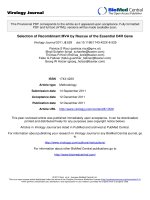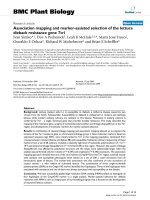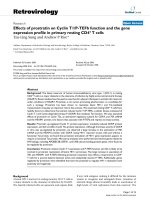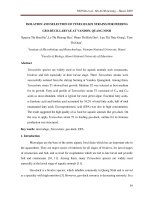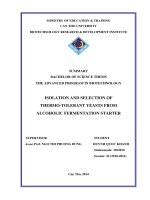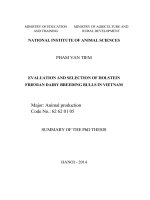Selection of iaa9 gene edited t1 tomato lines by crispr cas9
Bạn đang xem bản rút gọn của tài liệu. Xem và tải ngay bản đầy đủ của tài liệu tại đây (1.95 MB, 67 trang )
VIETNAM NATIONAL UNIVERSITY OF AGRICULTURE
FACULTY OF BIOTECHNOLOGY
------ ------
UNDERGRADUATE THESIS
TITLE:
SELECTION OF IAA9 GENE-EDITED T1 TOMATO
LINES BY CRISPR/CAS9
HANOI – 2022
VIETNAM NATIONAL UNIVERSITY OF AGRICULTURE
FACULTY OF BIOTECHNOLOGY
------ ------
UNDERGRADUATE THESIS
TITLE:
SELECTION OF IAA9 GENE-EDITED T1
TOMATO LINES BY CRISPR/CAS9
Student name
:
NGUYEN THUY LINH
Class
:
K63CNSHE
Student code
:
637416
Department
:
BIOTECHNOLOGY
Supervisor
:
TONG VAN HAI, M.S.
PHAM THI DUNG, Ph.D
HANOI – 2022
DECLARATION
I hereby declare that the graduate thesis work is mine. All research results have
been results during the implementation of the topic. The results and the data are
completely true and never appeared in any scientific report.
I also guarantee that the references and useful information for the topic are cited
and all help is appreciated.
Hanoi, December 22nd, 2022
Student
Nguyen Thuy Linh
i
ACKNOWLEDGEMENTS
During the process of implementing my graduation project, I received a lot of
attention and help from individuals and groups.
First of all, I would like to express my respect and deep gratitude to Tong Van
Hai, M.S. and Pham Thi Dung, Ph.D. for allowing me to carry out this work, and for
their huge efforts, enthusiasm, and support throughout the duration of the
undergraduate thesis.
Secondly, I would like to thank the teachers in the Faculty of Biotechnology
who have helped and taught me during my training at the university. Especially the
teachers of the Molecular biology and Applied Biotechnology department who
helped and gave me useful advice during carrying out.
Finally, I would like to sincerely thank my family members and friends who
always trust, support, and encourage me to complete this report.
Sincerely thank!
Hanoi, December 22nd, 2022
Student
Nguyen Thuy Linh
ii
CONTENTS
DECLARATION ................................................................................................. i
ACKNOWLEDGEMENTS ................................................................................ ii
CONTENTS ....................................................................................................... iii
LIST OF TABLES .............................................................................................. v
LIST OF FIGURES ............................................................................................ vi
LIST OF ABBREVIATIONS ........................................................................... vii
PART I. INTRODUCTION ............................................................................. 1
1.1. Preface .......................................................................................................... 1
1.2. Objective and Requirements ........................................................................ 2
1.2.1. Objective ................................................................................................... 2
1.2.2. Requirements ............................................................................................. 2
PART II. LITERATURE REVIEW................................................................ 3
2.1. The situation of tomato production in the world and Vietnam .................... 3
2.1.1. The situation of tomato production in the world ...................................... 3
2.1.2. The situation of tomato production in Vietnam ........................................ 5
2.2. Genome editing ............................................................................................ 8
2.3. CRISPR/Cas9 gene-editing system in plants ............................................. 11
2.4. Improvement of tomato physiological by CRISPR/Cas9 .......................... 15
2.4.1. Colors and pigments content in tomato fruits ......................................... 15
2.4.2. Tomato fruit ripening and shelf life ........................................................ 16
2.4.3. Production of parthenocarpic tomato fruits ............................................ 18
2.4.4. Generation of dwarfed tomato cultivars.................................................. 19
2.4.5. Characterization of senescence-related genes in tomato ........................ 19
2.4.6. Architecture of tomato inflorescence ...................................................... 20
2.4.7. Flowering time in tomato ........................................................................ 20
2.4.8. Development of abscission zone in tomato fruit..................................... 20
2.4.9. CRISPR/Cas9 and metabolic pathways studies in tomato plants ........... 21
2.4.10. CRISPR/Cas9 decreases the impact of environmental stress on
tomato ................................................................................................................ 21
2.4.11. Role of CRISPR/Cas9 in tomato resistance to biotic stress .................. 22
2.4.12. CRISPR/Cas9 can produce herbicide-resistant tomato plant ............... 24
2.4.13. CRISPR/Cas9 can identify genes functions in tomato plant ................ 24
PART III. MATERIAL AND METHODS ................................................... 25
3.1. Location and time for research ................................................................... 25
3.1.1. Research location .................................................................................... 25
iii
3.1.2. Time for research .................................................................................... 25
3.2. Material ...................................................................................................... 25
3.2.1. Subjects ................................................................................................... 25
3.2.2. Key equipment ........................................................................................ 31
3.2.3. Chemicals ................................................................................................ 31
3.3. Methods ...................................................................................................... 32
3.3.1. DNA extraction ....................................................................................... 32
3.3.2. Selection of mutant T1 plants by molecular markers ............................. 32
3.3.3. Evaluation of agro-biological characteristics of tomato lines................. 33
PART IV. RESULTS AND DISCUSSION ................................................... 35
4.1. Selection of editing plants in the T1 generation ........................................ 35
4.1.1. DNA extraction ....................................................................................... 35
4.1.2. Selection of T1 plants containing homozygous edited gene by
molecular markers ............................................................................................. 38
4.2. Agro-biological characteristics of the edited T1 lines ............................... 42
4.2.1. Growth pattern......................................................................................... 42
4.2.2. Growth stages .......................................................................................... 43
4.2.3. Some characteristics of leaf morphology and plant structure ................. 44
4.2.4. Some morphological characteristics, flower structure and bloom
characteristics .................................................................................................... 47
4.2.5. Yield and yield components .................................................................... 49
PART V. CONCLUSION AND SUGGESTION.......................................... 51
5.1. Conclusion .................................................................................................. 51
5.2. Suggestion .................................................................................................. 51
REFERENCES ................................................................................................ 52
iv
LIST OF TABLES
Table 2.1. The situation of tomato production in the world ............................................3
Table 2.2. Tomato production of the 10 largest producing countries in the world
from 2016 to 2020 ...........................................................................................................4
Table 2.3. Area, yield, and output of tomatoes in Vietnam from 2015-2019 .................6
Table 2.4. Area, yield, and output of the top 10 provinces and cities nationwide in
2017 .................................................................................................................................6
Table 2.5. Summary of gene-edited crop species using CRISPR/Cas9 system .................13
Table 3.1. Regeneration efficiency and morphological and genotypic results of T0
generation IAA9 gene-edited plants of two tomato lines TP1-1 and TP195-2 ............. 29
Table 4.1. OD measurement results of tomato DNA ....................................................36
Table 4.2. Growth stages and some morphological characteristics of plant structure ..46
Table 4.3. Inflorescence structure, flowering characteristics ........................................48
Table 4.4. Yield and yield components .........................................................................50
v
LIST OF FIGURES
Figure 2.1. Tomato production by regions of the world ............................................................. 5
Figure 2.2. The workflow of CRISPR/Cas9-based gene editing in plants ............................... 12
Figure 2.3. Data on research articles published on CRISPR/Cas9 from 2016 to 2020 ............ 14
Figure 2.4. The number of genes modified using the CRISPR/Cas system with the
aim of crop improvement. ........................................................................................................ 14
Figure 2.5. Carotenoid biosynthesis pathway in tomato plant in rectangular shapes ............... 16
Finger 3.1. The 12,068 bp IAA9 lv2 vector was transformed into Agrobacterial tumerfacies
GV3101 for IAA9 gene editing ................................................................................................ 27
Finger 3.2. Samples of shoot and shoot formation of T0 tomato lines TP195-2...................... 28
Finger 3.3. T-DNA testing on T0 generation IAA9 gene-edited plants (TP1-1) ..................... 29
Finger 3.4. T-DNA testing on T0 generation IAA9 gene-edited plants (TP195-2) ................. 29
Finger 3.5. PCR product multiplying exon 1 gene IAA9 region of large plants of TP1-1
parents ....................................................................................................................................... 30
Finger 3.6. PCR product multiplying exon 1 gene IAA9 region of large plants of TP195-2
parents ....................................................................................................................................... 30
Finger 3.7. Sequencing exon 1 gene IAA9 ............................................................................... 30
Finger 4.1. Total DNA electrophoresis of T1 lines (408) ........................................................ 37
Finger 4.2. Total DNA electrophoresis of T1 lines (701) ........................................................ 37
Finger 4.3. Total DNA electrophoresis of T1 lines (704) ........................................................ 38
Finger 4.4. PCR products multiplying the IAA9 gene region of plants (408 and 704) ............ 38
Finger 4.5. Cutting site of enzyme HindIII .............................................................................. 39
Finger 4.6. Cut PCR products of T1 individuals (408) of parental origin from TP1-1 line
by HindIII enzyme (600 and 370 bp) ....................................................................................... 39
Finger 4.7. PCR products of individuals T1(701) have parental origin from line TP195-2 .... 40
Finger 4.8. Cutting site of enzyme AluI ................................................................................... 41
Finger 4.9. Cut PCR products of T1(704) individuals of parental origin from TP195-2
line with AluI enzyme (560 and 410 bp) .................................................................................. 41
Finger 4.10. T1-701 plants with developed cotyledons ........................................................... 42
Finger 4.11. Leaf form of T1-408 line and parental line ......................................................... 45
Finger 4.12. Simple inflorescence in T1-408 tomato line. ....................................................... 47
vi
LIST OF ABBREVIATIONS
alc
Alcobaca
ALS
Acetolactate synthase
ARFs
Auxin Response Factors
BeYDV
Bean yellow dwarf virus
Blc
Beta-lycopene cyclase
Cas9
CRISPR-associated protein-9 nuclease
CBEs
Cytidine base editors
CP
Coat protein
CRISPR
Clustered Regularly Interspaced Short Palindromic Repeats
crRNA
CRISPR RNA
CRTISO
Carotenoid isomerase
CVYV
Cucumber vein yellowing virus
D
Determinant
ERF
Ethylene-responsive factor
GABA
Gamma-aminobutyric acid
gRNA
Guide RNA
ID
In-determinant
j
Jointless
j2
Jointless2
JAs
Jasmonates
LCY E
Lycopene cyclase
LCYB1
Lycopene beta cyclase 1
MAPK3
Mitogen-activated protein kinase3
MDH
Malate dehydrogenase
MeJA
Methyl jasmonate
MLO
Mildew resistance locus O
NarCh
Naringenin chalcone
nor
Non-ripening
NPR1
No express or pathogenesis-related 1
vii
PAM
Protospacer adjacent motif
PG2a
Polygalacturonase 2a
PL
Pectate lyase
PRSV-W
Papaya ring spot mosaic virus-W
PSY1
Phytoene synthase I
rep
Replicase
R-genes
Resistance genes
rin
Ripening inhibitor
RNP
Ribonucleoprotein
RTDS
Rapid Trait Development System
SBPase
Sedoheptulose-1,7-bisphosphatase
SD
Semi-determinant
S-genes
Susceptibility genes
sgRNA
Single guide RNA
SlAGL6
SlAGAMOUS-LIKE 6
SlCBFs
C-repeat binding factors
SP5G
Self-Pruning 5G
TMF
Terminating Flower
tracrRNA
Trans-activating crRNA
TYLCV
Tomato yellow leaf curl virus
VIGS
Virus-induced gene silencing
ZYMV
Zucchini yellow mosaic virus
viii
PART I. INTRODUCTION
1.1. Preface
Tomato (Solanum lycopersicum) belongs to the vegetable ubiquitously
grown all over the world. Global tomato production reached over 180 million tons
(2020). Global trading involving tomatoes relies on processed commodities like
purees, sauces, tinned tomatoes, and pastes, etc. apart from tomato fruits for
domestic consumption. Hitherto, tomato is regarded as a universally important
and popular horticultural crop aiding in nutraceutical benefits due to the presence
of healthy ingredients like ascorbic acid (vitamin C), β-carotene (pro-vitamin A),
folate, potassium, flavonoid, and rich antioxidants potentials with lycopene
contents (Murugesan et al., 2021).
In northern Vietnam, tomatoes are usually grown in the winter season. They
are planted in September and harvested in January and February of the next year.
This is the main season, so tomatoes have a very high yield but the selling price
is very low. Meanwhile, in the spring-summer crop, from April to August, the
demand for tomatoes is high, the selling price is 3-5 times higher, but the output
is not. The reason is that the tomato varieties grown in Vietnam are not heated
tolerant. The ability to produce fruit in high-temperature conditions is related to a
growth hormone called Auxin.
Plant hormones regulate plant growth and development at all stages, and
are controlled by internal signal transduction and environmental cues. The
fertilization-independent fruiting and seed development needed for parthenocarpy
is controlled by the cross-talk of phytohormones. Parthenocarpy is initiated by
auxin, and the underlying molecular mechanisms have been extensively
characterized. The protein factors AUXIN-INDUCED (Aux/IAA) and AUXIN
RESPONSE FACTORS (ARFs) are the key regulators in auxin signaling, in
which the auxin receptor TIR1 enhances degradation of the negative regulator
Aux/IAAs via the 26S proteasome pathway to activate the auxin transcription
factor ARF by inhibiting its interaction with Aux/IAA. Among the large number
of AUX/IAAs and ARFs, Aux/IAA9 (IAA9) and ARF8 are involved in tomato
1
fruit development to repress fruit initiation without fertilization. Genetic
parthenocarpy identified by classical breeding has been used in only a limited
number of species and cultivars. More recently, the emergence of genome editing
technologies enabling direct and precise genome modification has allowed gene
replacement or target-specific gene insertion via homologous recombination, and
site-specific gene deletion or insertion via non-homologous end joining on the
target of interest by using custom-engineered nucleases. The most widespread
genome editing technology in current use is the clustered regularly interspaced
short palindromic repeat (CRISPR)/CRISPR-associated protein-9 nuclease
(Cas9) system, which consists of Cas9 nuclease and a guide RNA (gRNA) that
targets the genomic sequence of interest. The efficacy of the CRISPR/Cas9
system has been proven in both model plants and many crop plants, such as rice,
sorghum, wheat, maize, sweet orange, soybean, potato, apple, and tomato. The
CRISPR/Cas9 system efficiently introduces site-directed mutations in
regenerated plants (T0) as well as later generations (Risa et al., 2017).
With the goal of creating heat-resistant tomato varieties, in the recently, the
Department of Molecular Biology and Applied Biotechnology has conducted a
research project “Using CRISPR/Cas9 system to orient mutation on IAA9 gene in
tomato plants”, thereby creating a source of T0-generation gene editing material.
To select high-yielding, heat-tolerant tomato lines in the T1-generation, I conduct
the project: “SELECTION OF IAA9 GENE-EDITED T1 TOMATO LINES
BY CRISPR/CAS9”.
1.2. Objective and Requirements
1.2.1. Objective
- Selection of T1 plants that have been edited with the IAA9 gene.
- Evaluation of agro-biological characteristics of edited tomato lines.
1.2.2. Requirements
- Tomato DNA extraction.
- Conducted PCR reactions to select of gene-edited T1 tomato plants.
- Evaluation of agro-biological characteristics of edited tomato lines.
2
PART II. LITERATURE REVIEW
2.1. The situation of tomato production in the world and Vietnam
2.1.1. The situation of tomato production in the world
Tomato is a crop that is accepted as a food with high economic efficiency,
economic efficiency, and use value. In the world, many new varieties have been
bred to meet people’s increasing needs in both quantity and quality. Therefore,
the area, productivity, and production of tomatoes are increasing. Products made
from tomatoes are also very diverse, increasing the value of tomatoes.
Table 2.1. The situation of tomato production in the world
Area
Yield
Output
(ha)
(ton/ha)
(ton)
2016
4.854.457
36,54
177.382.876
2017
4.876.142
36,50
178.024.027
2018
5.004.555
36,01
180.231.376
2019
4.999.181
36,60
183.014.805
2020
5.051.983
36,98
186.821.216
Year
Source: FAOSTAT data, 2021
According to the Food and Agriculture Organization of the United Nations,
the area of tomato production in 2016 and 2017 reached 4,854,457 ha and
4,876,142 ha. The area increased in 2018, 2019, and 2020 but was not significant.
The yield of tomatoes in 5 years (2016-2020) fluctuated slightly, around 36.0
tons/ha. In terms of output, due to the increasing area over the years, the output
also increased gradually, from 177,382,876 tons (in 2016) to 186,821,216 tons (in
2020). With the above output, the average per capita consumption is about 22 kg
of fruit/person/year. That confirms tomato is an important crop in the agriculture
of many countries around the world.
In the last 5 years from 2016 to 2120, Asia has the world's largest tomato
area and production, accounting for about 61.3% of total production, followed by
the Americas with 13.9% of total output. Europe about 12.9%, Africa about
11.6%, and elsewhere 0.2%. Tomatoes are grown mainly in temperate and
3
tropical countries. China, India, and the US are the top 3 tomato-producing
countries in the world.
Table 2.2. Tomato production of the 10 largest producing countries in the world
from 2016 to 2020
Year
Country
Global
2016
2017
2018
2019
2020
177.382.876 178.024.027 180.231.376 183.014.805 186.821.216
China
57.432.109
59.290.552
61.027.455
62.974.342
64.865.807
India
America
18.732.000
29.814.000
20.708.000
23.422.800
19.759.000
13.812.400
19.007.000
15.878.400
20.573.000
18.365.700
Turkey
12.600.000
12.750.000
12.150.000
12.841.990
13.204.015
Egypt
7.320.714
6.729.004
6.777.754
6.814.460
6.731.220
Italy
6.437.572
6.015.868
5.798.100
5.777.610
6.247.910
Iran
5.828.557
4.894.956
4.930.169
5.457.855
5.787.094
Spain
5.233.542
5.163.466
4.7686.00
5.000.560
4.312.900
Brazil
4.166.789
4.225.414
4.126.988
3.920.997
3.753.595
Mexico
4.047.171
4.243.058
4.559.375
4.271.914
4.137.342
Source: FAOSTAT data, 2021
According to FAO statistics in 2020, the 10 countries with the largest
tomato production are China, India, the US, Egypt, Italy, Iran, Spain, Brazil, and
Mexico... accounting for over 75%, all the remaining countries account for 25%
of the total world tomato production. China is the leading country in terms of
production area, as well as tomato output in the last 5 years, has increased, from
2016 output reached 57,432,109 tons, 2020 output reached 64,865,807 tons, then
India and Turkey. In the five years of 2016-2020, the area and production of
tomatoes in the US decreased, production from 29,814,000 tons in 2016 to
18,365,700 tons in 2020, but still ranked third in the world. The remaining
countries are countries with close, stable output with decent growth.
4
Figure 2.1. Tomato production by regions of the world
The situation of tomato consumption in different countries is also very
different. According to a summary of the Fruit and Vegetable Research Institute,
Greece consumes 187.1 kg of tomatoes/person/year, Turkey consumes 107
kg/person/year, and Italy about 95 kg/person/year (Kandel et al., 2016).
2.1.2. The situation of tomato production in Vietnam
In Vietnam, tomatoes have been grown for a long time, so far tomatoes are
still the main fruit vegetables prioritized for development by the state, grown
mainly in the northern plains and midlands such as Ha Noi, Hai Duong, Vinh
Phuc... According to statistics from the Department of Crop Production, Ministry
of Agriculture and Rural Development, the tomato growing area in the 5 years
from 2015 to 2019 increased from 2015-2017 and decreased from 2017-2019
(Table 2.3). In 2015, the tomato growing area of the whole country reached
23,917.8 ha, the yield was 25.79 tons/ha, the output reached 616,840.1 tons, in
2017 the tomato growing area of the whole country increased to 25,483.4 ha, and
productivity reached 28.71 tons/ha, output reached 731,628.4 tons and in 2019
the area decreased to 23,791.0 ha, the yield was 26.56 tons/ha, output reached
673,194.5 tons. Thus, the annual tomato planting area ranges from 23-25 thousand
hectares, and the yield fluctuates around 25-28 tons/ha.
5
Table 2.3. Area, yield, and output of tomatoes in Vietnam from 2015-2019
Year
Area (ha)
Yield (ton/ha)
Output (ton)
2015
23.917,8
25,79
616.840,1
2016
23.097,7
27,40
632.876,9
2017
25.483,4
28,70
731.480,0
2018
24.156,5
27,40
660.600,0
2019
23.791,0
26,56
673.194,5
Source: General Statistics Office (2020)
Due to specific characteristics, such as seasonal structure and ecological
conditions, tomato plants are mostly produced in the provinces of the Red River
Delta and Lam Dong area. The area and production of tomatoes produced in these
two regions account for over 62% of the national tomato production (Table 2.4).
Table 2.4. Area, yield, and output of the top 10 provinces and cities nationwide in
2017
2017
Province
Area
Yield
Output
(ha)
(ton/ha)
(ton)
Ha Noi
1.324,2
27,25
36.084,45
Hai Duong
1.053,0
25,20
26.535,60
Hai Phong
809,7
28,94
23.432,72
Hung Yen
778,1
27,43
21.343,28
Nam Đinh
1.453,0
26,92
39.114,76
Bac Giang
791,9
21,97
17.398,04
Nghe An
770,5
13,16
10.139,78
Gia Lai
988,1
12,87
12.716,85
Lam Dong
6.275,3
46,50
291.801,45
Tien Giang
797,7
21,77
17.365,93
Source: General Statistics Office (2018)
Sowing time of tomatoes in the Red River Delta: Summer - Autumn
sowing seeds in the period of July 15 - August 20, Winter-Spring crop August
30 - October 30, and Spring - Summer crop January 20 - February 20. The
6
tomato varieties planted in the main area are Mongan T11, Savior, HT160,
HT42, BM199, VL2000, Gandeva, and VL3000. The nothern provinces with
large production areas are Ha Noi, Hai Duong, Hai Phong, Nam Dinh, and Bac
Giang... For the Central Highlands, like Lam Dong, tomatoes are grown all
year round. Popular varieties in production in recent years are 386, Red
Diamond, Anna, Savio, and Lahay, which Lahay variety is used for greenhouse
production in Lam Dong.
Through Table 2.4. found that the planting area, yield, and output of
tomatoes in Lam Dong reached the highest. The tomato growing area of this
province in 2017 reached 6,275.3 hectares, the yield reached 46.5 and the output
reached 17,365.93 tons. The reason the productivity in Lam Dong is high is that
the farms have applied scientific and technological advances to tomato
cultivation. More than 80% of the tomato growing area in Lam Dong is grown in
greenhouses, with irrigation systems, against insects and external agents. On the
other hand, the weather conditions here are also very suitable for the development
of tomato plants. Tomato is a plant with high economic efficiency, especially in
specialized farming areas such as Don Duong and Duc Trong districts. However,
in the past few years, this specialized farming area has only used 1-2 main tomato
varieties for a long time, leading to the deterioration of varieties, and severe
infection with many diseases, especially late blight.
For the provinces of the Red River Delta such as Ha Noi, Hai Duong, Hai
Phong, Hung Yen, Bac Giang... The level of application of scientific and technical
progress on tomato plants in these localities has changed very quickly, people are
very active in learning and applying for new scientific and technical advances,
new technologies in farming such as off-season tomato growing techniques,
boldly applying new varieties, and new plant protection solutions, application of
disease-resistant rootstock… There are many professional tomato growing areas,
a good market for consumption. In specialized farming areas, farmers with
experience in growing tomatoes off-season are often those with high levels of
intensive farming. However, the level of application of advanced techniques and
7
suitable new varieties is not uniform across localities. Therefore, tomato yield in
this area is not high and fluctuates around 25 tons/ha. On the other hand, tomatoes
in this region are mainly grown directly in the field, subject to many
environmental influences and especially heat-tolerant tomato varieties for offseason planting to improve the economic value of tomatoes are still quite modest.
In the future, to increase the value of tomato plants, it is necessary to breed tomato
varieties with heat tolerance to develop off-season planting.
2.2. Genome editing
Genome editing technologies have wide practical applications for solving
one of the most important tasks of modern biotechnology - the creation of new
varieties of crops, which are high-yielding and resistant to abiotic and biotic
stresses and also have high nutritional value. To this end, a genome editing system
has been used in plant breeding (1) to insert point mutations similar to natural
SNPs, (2) to make small modifications to gene function, (3) for integration of
foreign genes, (4) for gene pyramiding and knockout, and (5) for the repression
or activation of gene expression, as well as (6) epigenetic editing (Kumar and
Jain, 2015).
For example, the use of ZFN in Arabidopsis thaliana and Zea mays has led
to the successful development of herbicide-tolerant genotypes through the
insertion of herbicide-resistance genes into targeted sites in the genome (Li et al.,
2013). ZFN was also used for the targeted modification of the endogenous malate
dehydrogenase (MDH) gene in plants and the plants containing modified MDH
have shown increased yield (Shukla et al., 2013). ODM technique has been
significantly advanced through Cibus Rapid Trait Development System (RTDS)
(Sauer et al., 2016) and this technology has been successfully applied in several
crops. Applications include but are not limited to the generation of herbicide
tolerance, insect resistance, enhanced disease resistance (bacterial and viral),
improved nutritional value, and enhanced yield without the introduction of
foreign genes as has been used in traditional genetic engineering approach for
crop development. Precise editing of CAC to TAC using ODM RTDS technology
8
has been demonstrated that converts BEP to GFP by changing Histidine (H66) to
Tyrosine (Y66) in GFP protein. This approach has offered a nontransgenic
breeding tool for crops.
Using the CRISPR/Cas9 technology, Jiang et al. (2017) have obtained “a
biotech” oil from Camelina sativa seeds with an improved fatty acid composition,
which makes it more beneficial to human health, more resistant to oxidation, and
more appropriate for the production of certain commercial chemicals including
biofuels. Soyk et al. (2017) used targeted mutagenesis of the SP5G
getomatoestomato to create plants with rapid flowering and more compact bushes,
which in turn resulted in an earlier harvest. In another effort, Osakabe et al.
(2016), using the CRISPR-induced mutagenesis of the OST2 gene in Arabidopsis,
were able to obtain new alleles that confer salt stress resistance to plants.
Modulation of gibberellin biosynthesis by genome editing methods has
allowed the creation of dwarf fruit trees (Peng et al., 1999), which have great
potential for increasing higher density through higher-density plantings and
reduced labor costs. This results in a reduction of land, water, pesticide, and
fertilizer use (Hollender and Dardick, 2015). In addition, genome editing for
inhibition of ethylene biosynthesis, which plays a very important role in the fruit
ripening process or its signaling pathways, enables the creation of new varieties
with extended shelf life (Xiong et al., 2015).
A major area of application of genome editing approaches in plant breeding
is to create varieties resistant to various pathogens and/or pests. These methods
have been used for the modification of the key plant immunity stages at different
levels in several crops. This goal can be achieved by modifying (1) susceptibility
genes (S-genes), (2) resistance genes (R-genes), (3) genes regulating the
interaction between the effector and target, and (4) the genes regulating plant
hormonal balance (Andolfo et al., 2016). For example, wheat genotypes resistant
to powdery mildew disease were obtained by TALEN and CRISPR/Casmildew
resistance editing on mildew resistance locus O (MLO) (Wang et al., 2014).
9
Genome editing technologies have also been used to produce plants resistant to
bacterial leaf blight, caused by Xanthomonas oryzae pv. oryzae (Li et al., 2012).
The CRISPR/Cas9 system has been investigated for its efficacy in
providing interference against geminiviruses by using a transient transformation
system such that N. benthamiana degradation/suppression of curly top virus
genome by single guide RNA/Cas9 (sgRNA/Cas9) has been demonstrated (Ji et
al., 2015). In other efforts, where sgRNAs specific for tomato yellow leaf curl
virus (TYLCV) or bean yellow dwarf virus (BeYDV) sequences were introduced
into N. benthamiana plants expressing Cas9 endonuclease and challenged with
the corresponding viruses, it was demonstrated that the CRISPR/Cas9 system not
only targeted viruses for degradation but also introduced mutations at the target
sequences due to interference with the copy number of freely replicating viruses.
Metabolic pathways that regulate hormonal balance can also be modified
using genome editing technologies to enhance the immunomodulatory component
of the plant's immune system. This can be achieved by deactivating the ethyleneresponsive factor (ERF). In particular, the ethylene-dependent pathway in rice has
been successfully modified by CRISPR/Cas9-mediated target OsERF922 gene
mutations, resulting in increased resistance to Magnaporthe oryzae.
CRISPR/Cas9 has been used to knock out the eIF4E gene that encodes the
eukaryotic translation initiation factor essential for the translation of viruses, in
Cucumis sativus, and that knockout confers resistance to viruses such as cucumber
vein yellowing virus (CVYV), zucchini yellow mosaic virus (ZYMV), and
papaya ring spot mosaic virus-W (PRSV-W). In addition, CRISPR/Cas9 was
demonstrated to be an efficient system for rapid and efficient genome editing in
Phytophthora sojae, an oomycete pathogen of Soybean, by modifying the
pathogenicity gene (Avr4/6), thereby opening up an avenue for the much needed
functional genomics work in Phytophthora sojae towards the ultimate goal of
controlling this pathogen (Fang and Tyler, 2016).
Similarly, existing genome editing
methods,
in particular, the
CRISPR/Cas9 method, have been successfully used to obtain plants resistant to
10
herbicides. For example, editing of the ALS2 gene in maize (acetolactate synthase
or ALS is a key enzyme in the biosynthesis of amino acids in plants and has been
inhibited by sulfonylurea herbicides) allowed the creation of a mutant corn plant
resistant to chlorsulfuron (Svitashev et al., 2015).
Another interesting area of biotechnology where the CRISPR/Cas9 system
has significant application is the development of plants capable of synthesizing
human proteins such as insulin, necessary for patients with diabetes mellitus, or
albumin, which is used in the treatment of hemorrhagic shock, burns,
hypoproteinemia, and cirrhosis (Hastings and Wolf, 1992). At present, albumin is
prepared from human plasma which is in very limited supply; however, global
demand for albumin is constantly growing and currently is equal to 500 tons per
year. To meet the growing needs human albumin gene is already introduced into
the rice genome using genomic engineering techniques (He et al., 2011). Such
expressed proteins can be isolated from plant and animal tissues, where it is
synthesized, and after clarification, they can be used for medical purposes.
Thus, as described above and extensively referenced herein, these novel
genome editing techniques are being widely used for crop improvement including
new bioenergy crop developments (Bosch and Hazen, 2013). However, the use of
tissue culture with these GEEN methods may also create complexities that could
slow the process of genome editing.
2.3. CRISPR/Cas9 gene-editing system in plants
According to the classification of the Cas protein, CRISPR/Cas systems
have been divided into two classes and five types. The type II CRISPR/SpCas9
system from Streptococcus pyogenes has been modified and developed as
versatile GE tools for different applications (Hsu et al., 2014). It consists of two
core components: the guide RNA (gRNA or sgRNA) and the Cas9 protein. The
gRNA constitutes CRISPR RNA (crRNA) and trans-activating crRNA
(tracrRNA). The former contains a ~20 nt fragment (also known as a spacer,
complementary to a specific site of target genes), followed by a protospacer
adjacent motif (PAM) in the target genes of interest. Under the guidance of gRNA,
11
Cas9 nuclease creates DSBs at ~3 bp upstream of the PAM motif (Jinek et al.,
2012). The cleavage repaired in the NHEJ way usually results in gene knockout
or loss of protein function (Liu et al., 2019). Alternatively, when an exogenous
DNA repair template is provided, HDR can be triggered, resulting in the
introduction of the repair template into a target genomic region (Sun et al., 2016).
In plants, CRISPR/Cas9-based gene-editing consists of multiple steps as shown
in Figure 2.2., including the selection of target sites, designing and synthesis of
sgRNA, delivery of transformation carrier or ribonucleoprotein (RNP) in plant
cells, transformation, and screening of gene-edited plants. Currently, the plant
CRISPR/Cas9 and its derived system have shown various genome-editing
abilities, such as gene knock-in, knockout, knockdown, expression activation as
well, and simultaneous editing on multiple genes have contributed to pathwaylevel research.
Figure 2.2. The workflow of CRISPR/Cas9-based gene editing in plants
Source: />
Since the first use of CRISPR/Cas systems for plant gene editing in 2013,
many researchers have focused on its application in increasing crop yield, quality,
and stress resistance. To date, CRISPR/Cas9-mediated genome editing has been
12
reported in 41 food crop species, 15 industrial crops, 6 oil crops, 8 ornamental
crops, 1 fiber crop, and feed crop (Table 2.5) (Ricroch et al., 2017). Furthermore,
literature retrieval showed that in the last five years, the number of publications
that used CRISPR/Cas9 for crop improvement increased greatly from 5 to 125.
Among them, nearly one-third of articles reported improving crop quality by
interfering with negative regulatory factors (Figure 2.3.). To demonstrate the
extensive application of gene editing in different crop species, we summarized
publications on the number of edited genes for each crop species, with the top 3
of those being rice, tomato, and oilseed rape (Figure 2.4.).
Table 2.5. Summary of gene-edited crop species using CRISPR/Cas9 system
Crops in Six
Categories
Species
Feed Crops
Alfalfa
Fiber Crops
Cotton
Apple, Banana, Barley, Basil, Blueberry, Cabbage, Carrot, Cassava,
Chickpea, Chill, Citrus, Coconut, Cowpea, Cucumber, Date Palm,
Food Crops
Grapefruit, Grapes, Kale, Kiwifruit, Lactuca sativa, Lemon, Lettuce,
Lychee, Maize, Melon, Oats, Orange, Papaya, Pear, Pepper, Potato,
Pumpkin, Rice, Saffron, Strawberry, Sugar beet, Sweet potato,
Tomato, Watermelon, Wheat, Yam
Crops
for
Cichorium intybus, Coffee, Dandelion, Hevea brasiliesis, Jatropha
Industrial
curcas, Millet, Papaver, Parasponia, Salvia miltiorrhiza, Sorghum,
Use
Sugarcane, Switchgrass, Tragopogon, Tripterygium wilfordii
Oil Crops
Canola, Flax, Oil palm, Oilseed rape, Soybean, Sunflower
Ornamental
Lily, Lotus, Petunia, Poplar, Rose, Sedum, Snapdragon, Torenia
Crops
fournieri
Source: />
13
Figure 2.3. Data on research articles published on CRISPR/Cas9 from 2016 to 2020
Source: />
Figure 2.4. The number of genes modified using the CRISPR/Cas system with the
aim of crop improvement.
Source: />
14
2.4. Improvement of tomato physiological by CRISPR/Cas9
2.4.1. Colors and pigments content in tomato fruits
Tomato fruit color is one of the most critical agronomic traits that affect its
marketing value. Some consumers prefer to eat red tomato fruit as European and
American, while other Asia countries, especially in China and Japan like pink
tomato fruits (Lin et al., 2014). Using CRISPR/Cas9 to disrupt gene and s control
pigment accumulation enable researcher to manipulate the color of tomato fruit.
The accumulation of a yellow-colored flavonoid compound called
naringenin chalcone (NarCh) in the peel of tomato fruit is controlled by the Y
gene, which encodes the R2R3-MYB transcription factor (SlMYB12) (FernandezMoreno et al., 2016). Monogenic recessive yellow (y) will present NarCh
accumulation and result in pink fruits and tomatoes (Ballester et al., 2010). Five
null alleles have been identified for the Y gene and used in pink tomato breeding
programs which need at least five years to get results with the risk of unfavorable
linkage drag. While by CRISPR/Cas9 system, the SlMYB12 gene was simply
disrupted to get elite red-fruited inbred lines in high efficiency to reach 90.9%
(Deng et al., 2018).
Moreover, depending on the carotenoid biosynthesis pathway in plants
(Ampomah-Dwamena et al., 2009), we can conclude that most genes that control
key enzymes in the carotenoid biosynthesis pathway in tomatoes were targeted by
the CRISPR system (Figure 2.5). Mutations in carotenoid isomerase (CRTISO)
and phytoene synthase I (PSY1) genes gave orange and yellow tomato fruits with
mutagenesis frequencies reached 90% and 70% respectively (McCormick and
Sheila, 2018). PSY1 accumulates lycopene during fruit ripening (Giorio et al.,
2008). Similarly, yellow fruit instead of red from psy1 mutants and pale yellow
corolla color instead of bright yellow from beta-carotene hydroxylase 2 (crtr-b2)
gene mutants were achieved through CRISPR/Cas9 way (D’Ambrosio et al.,
2018). The CrtR-b2 gene converts beta-carotene to xanthophylls in flower petals
(Stigliani et al., 2011). Furthermore, a multiplex CRISPR/Cas9 system was used
15
